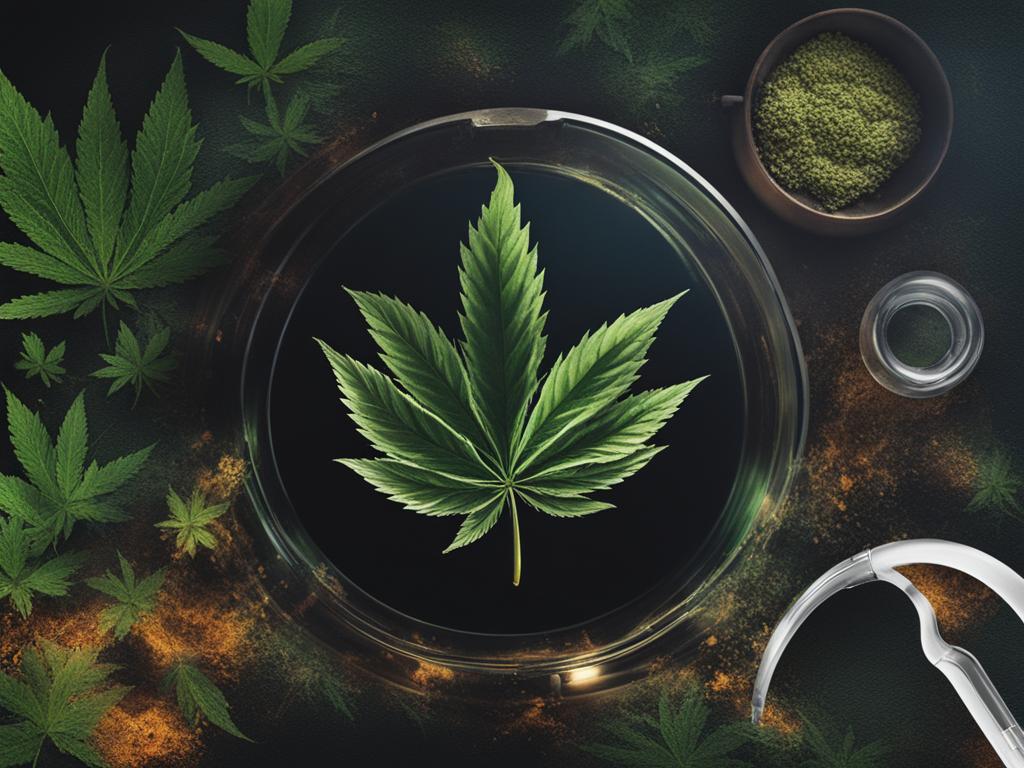As marijuana use becomes more widespread, it’s important for us to understand the potential negative impact of weed addiction. Many people are unaware of the risks of marijuana use, the consequences of cannabis dependence, and the increasing potency of today’s strains. In this article, we delve into the often under-discussed topic of weed addiction, examining its effects as well as the short-term and long-term risks associated with marijuana use.
Key Takeaways
- Marijuana use disorder impacts nearly 30% of users and has a higher risk for adolescents.
- Increased THC levels in marijuana elevate addiction potential and associated dangers.
- Short-term side effects of cannabis include altered perceptions, impaired coordination, and increased risk of accidents.
- Chronic weed use is linked to mental health issues and long-term cognitive decline.
- Increasing marijuana potency heightens the potential for negative reactions, especially for new users.
- Behavioral interventions, such as cognitive-behavioral therapy, can be effective in treating weed addiction.
Understanding Marijuana Use Disorder and Its Prevalence
Becoming familiar with Marijuana Use Disorder and its prevalence is the first step in addressing the issue of cannabis addiction. This disorder is marked by diverse symptoms such as an inability to quit despite genuine intent, an insatiable yearning for the drug, and unwavering use in hazardous situations like driving.
Notably, Marijuana Use Disorder is associated with elevated risks of cognitive deficiencies like memory impairment and hindered learning abilities. As studies reveal, enhanced concentrations of Tetrahydrocannabinol (THC)—the primary psychoactive component of cannabis—can exacerbate the risk of developing this disorder.
Increased THC levels in marijuana can result in a higher potential for addiction, especially when considering dispensary products that often boast THC concentrations ranging from 0% to 45%.
Let’s examine the signs of Weed Dependence and the factors contributing to the Prevalence of Cannabis Addiction:
- Persistent usage despite knowledge of adverse effects,
- Withdrawal symptoms upon cessation,
- Increased tolerance to the drug, requiring larger doses to achieve the desired effect,
- Continuation of use in spite of negative impacts on relationships, work, or school,
- Inability to control or reduce intake despite repeated attempts.
| Factors Contributing to the Prevalence of Cannabis Addiction | Role in Cannabis Addiction |
|---|---|
| Increased THC Concentration in Marijuana Products | Elevates the risk of addiction due to heightened psychoactive effects |
| Dispensary Products with High THC Levels | Significantly increases the potential for dependence, particularly among frequent users |
| Genetic Predisposition | Individuals with a family history of addiction may be more susceptible to cannabis addiction |
| Early Initiation of Marijuana Use | Adolescents are more prone to develop marijuana use disorder due to ongoing brain development |
| Co-occurring Mental Health Disorders | Persons with pre-existing mental health conditions might be at an increased risk of developing cannabis addiction |
Understanding the factors contributing to the Prevalence of Cannabis Addiction is crucial in addressing the growing issue of cannabis dependence. We must continue to raise awareness about the potential risks associated with marijuana use and advocate for effective prevention and treatment strategies.
Short-Term Side Effects and Immediate Risks of Cannabis
Short-term marijuana effects can be felt immediately after consumption, causing acute modifications in perceptions, mood, and motor skills. These immediate risks can be detrimental to the user’s mental health and overall safety. In this section, we will discuss the mental health impact of altered perceptions, impaired coordination and its consequences in high-risk situations, and how the methods of marijuana use can result in potency variation.

Altered Perceptions and Its Impact on Mental Health
Marijuana use has been known to induce altered perceptions, causing users to experience an altered state of reality. This can take the form of auditory, visual, and tactile sensory changes. The short-term impact of THC, the main psychoactive compound in marijuana, targets cannabinoid receptors in the brain that affect pleasure and other functions. This interaction can exacerbate pre-existing mental health conditions or trigger depression, anxiety, and even temporary psychotic reactions.
“The short-term impact of THC targets cannabinoid receptors in the brain that affect pleasure and other functions, thereby exacerbating pre-existing mental health conditions or triggering depression, anxiety, and even temporary psychotic reactions.”
Impaired Coordination and Risks in High-Risk Situations
One of the most immediate and observable side effects of marijuana use is impaired coordination. This can significantly heighten the risk of injury or death in situations that require alertness, such as driving or operating heavy machinery.
Data suggests marijuana usage can more than double the risk of a vehicular accident, with the combination of marijuana and alcohol causing even greater impairment. These cannabis-induced risks underscore the importance of monitoring one’s behavior and environment when engaging in marijuana use, especially in high-risk situations.
Cannabis Consumption Methods and Their Potency Variation
Cannabis consumption methods play a significant role in determining the potency and effects of the drug. With the increasing popularity of alternative methods of marijuana use, users are now exposed to varying levels of THC, posing potential risks related to potency variation.
| Methods of Marijuana Use | Potency Variation |
|---|---|
| Smoking | Moderate THC levels, depending on the strain |
| Vaping | Higher THC levels, especially with concentrated cartridges |
| Edibles | Variable potency based on serving size; delayed onset of effects |
| Dabbing | Significant THC levels due to concentrated extracts |
Emerging methods of consumption, such as dabbing and vaping, can deliver substantial levels of THC. This variability, especially with concentrates and high-THC strains, presents challenges in assessing the full scope of health consequences related to these practices. It is crucial for users to be aware of the potential dangers of potency variations to avoid unintended harm.
Long-Term Consequences of Chronic Weed Use
Recreational and medicinal use of marijuana is on the rise, but it is essential to understand the potential risks of chronic weed use. Heavy and long-term marijuana consumption can lead to several mental health conditions and significantly impact cognitive abilities and brain development, especially in adolescents.
The Link between Weed Addiction and Mental Health Conditions
Mental health conditions can significantly worsen or develop due to chronic weed use. Contrary to popular belief, long-term marijuana consumption might contribute to the aggravation of symptoms in schizophrenia and increasing the risk of psychosis.
“Marijuana’s cannabinoids can produce acute and temporary changes in mood, which can exacerbate existing mental health conditions or incite new ones, such as anxiety, depression, and even psychotic reactions.”
Moreover, marijuana use can adversely affect individuals who are predisposed to mental health issues, making it crucial to exercise caution and consult healthcare professionals when considering or using marijuana products.
Impact of Continued Usage on Cognitive Abilities and Brain Development
Chronic weed use, particularly during adolescence, can lead to an irreversible reduction in cognitive functions. Studies have demonstrated that long-term marijuana consumption can result in:
- Diminished IQ points
- Impaired learning capabilities
- Memory issues
It is due to the chronic marijuana impact on brain development. Teenagers and young adults are specifically at risk of experiencing significant brain alterations with continuous marijuana use. Neuronal connectivity and executive functioning are greatly affected, leading to potential long-term damage.
Knowing the risks associated with cannabis, it is critical for users to be educated on the potential dangers and opt for safe consumption practices, especially those vulnerable to mental health conditions or developmental disorders.
The Increasing Potency of Weed and Its Implications
With the increasing weed potency and elevated THC concentrations, the landscape of cannabis use has changed significantly. The average THC levels in marijuana have risen from 3.7% in the 1990s to nearly 15% today, with some dispensary products having an even higher concentration. This surge in potency of cannabis has critical implications for both new and experienced users, as it can lead to stronger and more adverse reactions, as well as an increased risk of addiction.

THC concentration implications directly influence the effects experienced by users. In particular, the increased potency can result in a more intense high, making it potentially harmful for new users unfamiliar with the drug. This can lead to feelings of paranoia, anxiety, and even hallucinations for those who are inexperienced.
“The higher the THC content, the stronger the effects on the brain—and the higher the risk of adverse reactions, particularly in new users.” — National Institute on Drug Abuse
Furthermore, the growing strength of marijuana also challenges experienced users by elevating the potential for dependence and addiction. Frequent exposure to high levels of THC can encourage habitual usage and ultimately lead to marijuana use disorder. It is crucial for users to be aware of these risks when consuming cannabis products with high THC concentrations.
- Short-term risks: The more potent the cannabis, the more intense and unpredictable the effects. For new users, this can result in panic attacks, confusion, and feelings of detachment.
- Long-term risks: Consistent exposure to high-potency cannabis can increase one’s vulnerability to marijuana use disorder. This, in turn, can lead to mental health issues such as a decline in cognitive function and the development of psychosis.
Understanding the implications of these changes in THC concentration and increasing weed potency is crucial for users who want to minimize the health risks and adverse effects associated with marijuana consumption.
Addressing Weed Addiction: Prevention and Treatment Options
We understand the importance of addressing weed addiction and providing effective prevention and treatment options. With weed addiction prevention, education plays a crucial role in raising awareness of the risks and consequences associated with cannabis use. By promoting healthy coping strategies and informed decision-making, we can prevent the onset of marijuana use disorder amongst individuals, particularly among vulnerable groups such as adolescents. Public awareness campaigns, comprehensive educational programs, and youth-targeted initiatives are all vital approaches to help reduce the prevalence of marijuana use disorder in our society.
Regarding treatment for cannabis addiction, there are a variety of options available for those struggling to overcome their dependence on marijuana. One of the most effective treatments for weed addiction is behavioral interventions, such as cognitive-behavioral therapy (CBT). CBT helps individuals understand and modify their thought patterns and behaviors in relation to marijuana use. Additionally, motivational incentives, such as positive reinforcement for achieving abstinence goals, can be employed to encourage and support individuals in their journey towards sobriety.
Overall, marijuana abuse rehabilitation requires a multidisciplinary approach that takes into account the unique needs and circumstances of each individual. This may include medical treatment for withdrawal symptoms, psychotherapy to address underlying mental health issues, and support groups to build a network of motivation and accountability. By offering evidence-based treatments and establishing a strong foundation for continued care, we can effectively assist individuals in overcoming their addiction to marijuana and help them achieve a healthier, more fulfilling life.
FAQ
What are the effects of Weed Addiction?
The effects of weed addiction can include cognitive deficits, such as impaired memory and learning capabilities, increased tolerance, withdrawal symptoms upon cessation, and persistent usage in unsafe situations, among others.
How prevalent is Marijuana Use Disorder?
Current research suggests that nearly 30% of marijuana users may develop a disorder, with a higher risk among adolescents and those who consume marijuana more frequently.
What are the short-term side effects of Cannabis?
Short-term side effects of cannabis include acute modifications in perceptions and mood, difficulties in coordination and problem-solving, exacerbation of pre-existing mental health conditions, and the triggering of depression, anxiety, and even temporary psychotic reactions.
How does impaired coordination due to cannabis use affect high-risk situations?
Impaired coordination, caused by cannabis use, significantly heightens the risk of injury or death in situations requiring alertness, such as driving. Data suggest that marijuana usage can more than double the risk of a vehicular accident.
How do different Cannabis consumption methods affect potency?
The potency of marijuana varies based on consumption methods, with emerging methods like dabbing and vaping delivering substantial levels of THC to the user. This variability presents challenges in assessing the full scope of health consequences related to these consumption practices.
What are the long-term consequences of Chronic Weed Use?
Long-term consequences of chronic weed use include the development or exacerbation of mental health issues, persistent decline in cognitive functions, and significant negative impacts on brain development, particularly in adolescents.
How does the increasing potency of Weed affect its users?
The increasing potency of marijuana, with higher THC levels, can lead to stronger and more adverse reactions, particularly in new users, and a heightened risk of addiction in frequent users.
What are some prevention and treatment options for Weed Addiction?
Treatment for weed addiction often involves behavioral interventions such as cognitive-behavioral therapy and motivational incentives. These strategies have shown efficacy in overcoming withdrawal symptoms, which include irritability, sleep disturbances, and intense cravings. Continued research and efforts are directed toward developing further evidence-based treatments for cannabis dependence.
Source Links
- https://www.cdc.gov/marijuana/health-effects/addiction.html
- https://www.hazeldenbettyford.org/addiction/marijuana-symptoms
- https://www.ncbi.nlm.nih.gov/pmc/articles/PMC4827335/
Author Profile

Latest entries
 BlogFebruary 20, 2024I Just Found the Ultimate Clog-Free Vape Cartridge! (Yes, They Exist!)
BlogFebruary 20, 2024I Just Found the Ultimate Clog-Free Vape Cartridge! (Yes, They Exist!) BlogJanuary 16, 2024In the Clouds with Creativity: A Blunt Encounter with Montreal’s Fluid Art Maestro
BlogJanuary 16, 2024In the Clouds with Creativity: A Blunt Encounter with Montreal’s Fluid Art Maestro BlogDecember 25, 2023Sativa: Enhancing Outdoor Adventures
BlogDecember 25, 2023Sativa: Enhancing Outdoor Adventures BlogDecember 25, 2023Enhancing Memory with Sativa
BlogDecember 25, 2023Enhancing Memory with Sativa





